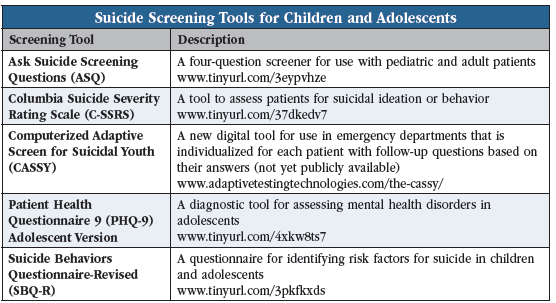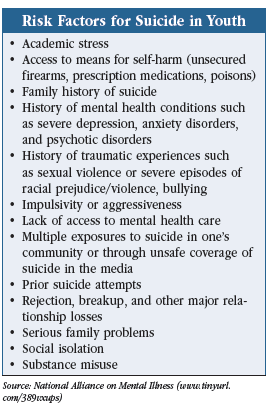Suicide in Children and Adolescents
Children and teenagers struggle with mental health crises at an alarming rate. Suicide deaths among 10- to 19-year-olds have increased by 60% over the past two decades, with one in five high school students seriously thinking about ending their lives and one in 10 making a suicide attempt (www.nimh.nih.gov/health/statistics/suicide). Suicide is now the second leading cause of death among 10- to 14-year-olds and the third leading cause of death for 15- to 24-year-olds. The percentage of annual visits to emergency departments (EDs) for youth self-injury and suicide has doubled in the past decade (Plemmons G et al, Pediatrics 2018;141(6):e20172426). 
So what’s going on? Recent stresses and isolation from the COVID-19 pandemic may be to blame (see our Q&A with Dr. Warren Ng in this issue for more on the child and adolescent mental health crisis). Experiences of structural racism and discrimination are additional contributing factors for some (Meza JI et al, Focus 2022;20(2):197–203). Ultimately, however, we don’t fully understand the striking increase in youth suicide attempts (Sheridan DC et al, JAMA Pediatr 2022;176(6):604–606). Nevertheless, there are steps we can take to mitigate the risks.
Risk factors and warning signs
The largest indicators for future suicide attempts or self-harm are past suicide attempts and self-harm. Other risk factors include a family history of suicide attempts, a history of mental health conditions, and substance misuse, to name a few (see “Risk Factors for Suicide in Youth” table for more).
Screening
Given the high rates of suicidality among preteens and teenagers, the American Academy of Pediatrics recommends universal screening for all kids ages 12 and above. When should we do screenings for younger kids? For youth ages 8–11, screen if patients present with behavioral health issues, if they or their family members raise a concern, or if they display warning signs such as acting out behaviors. Keep in mind that young children might express mental distress differently than their adolescent counterparts. Young children are more likely to experience “hallucinations” or display acting out behaviors as reasons for coming to the ED. Around a third of children ages 8–9 who present to the ED for these behaviors screen positive for suicide when asked (Cwik M et al, J Am Acad Child Adolesc Psychiatry 2021;60(5):537–540). For youth under age 8, screening is not generally indicated unless there are warning signs or the parent reports self-injurious or suicidal behavior. For more information, see: www.tinyurl.com/yxff3j4v.
 How do we screen kids for suicidality? The Ask Suicide Screening Questions (ASQ) screening tool is a publicly available, brief, and easy-to-use screener. The Suicide Behaviors Questionnaire-Revised (SBQ-R), the Columbia Suicide Severity Rating Scale (C-SSRS), and the Patient Health Questionnaire 9 (PHQ-9) Adolescent Version are also publicly available and easy to use (see “Suicide Screening Tools for Children and Adolescents” table for more).
How do we screen kids for suicidality? The Ask Suicide Screening Questions (ASQ) screening tool is a publicly available, brief, and easy-to-use screener. The Suicide Behaviors Questionnaire-Revised (SBQ-R), the Columbia Suicide Severity Rating Scale (C-SSRS), and the Patient Health Questionnaire 9 (PHQ-9) Adolescent Version are also publicly available and easy to use (see “Suicide Screening Tools for Children and Adolescents” table for more).
What can we do to reduce suicidal behavior among youth?
Create safe home environments
We can go a long way toward reducing suicidal behaviors by educating parents and caregivers to ensure their homes are safe environments. Suicide attempts are often impulsive events. Keeping potentially dangerous items (eg, medications, sharp objects, cleaning products, rope-like items) placed out of reach can make the difference between suicidal thoughts and possible death. If firearms are present in the home, it is critical that they be safely locked away.
Urge families to watch for changes in behaviors, academic progress, and sleeping or eating habits, as well as new physical complaints; these can all be early warning signs. Children may withdraw from their regular activities and the quality of their schoolwork may deteriorate. They may start giving away their possessions. Children and adolescents may say things like “I wish I was dead” or may joke about life not being worth living. Comments like these must be taken seriously.
Make a safety plan
Whenever possible, create a safety plan with the child or adolescent. Safety plans include a list of warning signs to help the youth identify triggers for suicidal thoughts, coping strategies to reduce the risk of self-harm, and sources of support (for a blank safety plan form, see: www.tinyurl.com/8cvbc7fs). Share this plan with the child’s parents and make sure it’s easy to find, eg, by having it stored on the child’s phone.
Encourage conversation
Many parents feel uncomfortable asking their kids about suicide. Some may worry that these questions will put the thought of suicide in their child’s head. It’s helpful to tell parents that these questions show children that someone cares about them, giving them an opportunity to talk about their problems.
It’s also important to remind parents to be mindful of the impact of family stressors and conflict on their kids. Children depend on their families to provide them the safety they need to move through normal developmental stages.
Provide additional resources
It is critical to provide kids and their families with resources and hotlines, including the National Suicide Prevention Lifeline, the crisis text line, and the new national 988 number for mental health help (see “Suicide Prevention Resources for Children and Adolescents” table on page 8). Some schools now include these numbers on the back of student ID cards to provide easy access for youth in crisis.
CARLAT VERDICT
Rates of suicidality among youth have increased over the last two decades. Perform suicide screening on all kids ages 12 and above, and
on younger kids based on their risk factors. Educate family members to watch for warning signs and provide them with lifeline numbers and crisis text lines (eg, 988). If guns are in the house, emphasize the importance of keeping them securely locked up.


_-The-Breakthrough-Antipsychotic-That-Could-Change-Everything.webp?t=1729528747)



